Press Release
Letter to Governor Kathy Hochul in Support of Election Alignment Bill
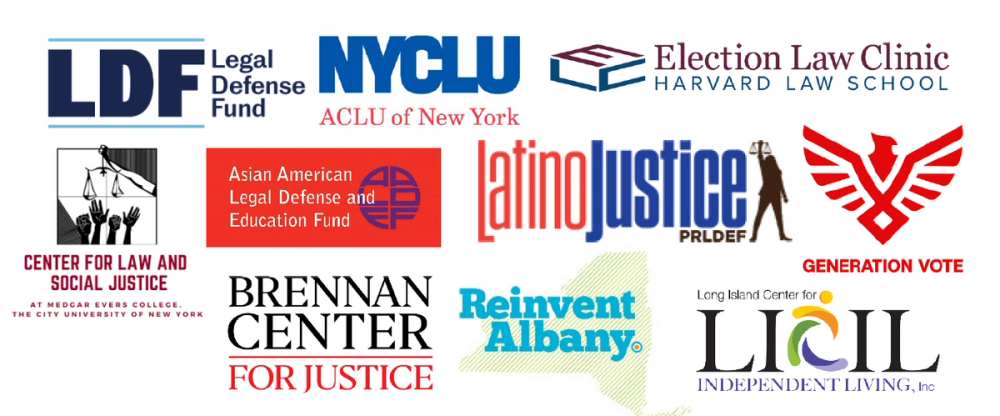
The Honorable Kathy Hochul
Governor of New York State
New York State Capitol
Albany, NY 12224
Re: Support for the Election Alignment Bill (A4282B/S3505B)
Dear Governor Hochul:
The undersigned organizations encourage you to sign Assembly Bill A4282B/Senate Bill S3505B (the “Election Alignment Bill”), which would move the timing of many local elections across the state to even-numbered years, on the same cycle as federal and state elections. As explained below, New York State’s current practice of holding local elections “off-cycle” in odd years is both racially discriminatory and discriminatory against young voters. Off-cycle elections exacerbate racial and age disparities in political participation and lead to under-representation of voters of color and young voters in local governments across the state. The Election Alignment Bill provides a critical opportunity to shift many of the off-cycle elections that produce these discriminatory effects to even years, yielding more representative turnout.
I. Background
Pursuant to existing New York law, towns and counties hold primary elections in June of odd-numbered years and general elections in November of odd-numbered years, which is “off-cycle” from federal and state elections held in even-numbered years. The Election Alignment Bill would shift these local contests to even-numbered years so they are “on-cycle” with federal and state elections. This measure would reduce burdens on voters, facilitate more accessible public education surrounding elections, and increase participation in elections for these critical local offices.
II. Off-Cycle Elections Can Exacerbate Racial Discrimination in Voting
a. Off-cycle elections have been shown to contribute to significant racial and age-based disparities in political participation
Studies have consistently shown that off-cycle elections significantly depress voter turnout,1 and in doing so disproportionately suppress participation in the democratic process by young people and people of color.2 Off-cycle elections increase the cost of participation—including arranging time off work, learning where and when to vote, and traveling to the polls—which, as research has shown, often makes voting burdensome for voters who historically face barriers to the ballot box, including young, low-income, and racial and ethnic minority votets.3 Aligning local elections with state and national elections “greatly reduces [that] cost of participation”4 for these voters to engage in local democracy, without reducing other voters’ opportunities to participate.5 In moving to hold these elections alongside national contests, the Election Alignment Bill takes a meaningful step—heralded by some scholars as “the single most important change”6—to both increase voter turnout and ensure that the electorate is truly representative of the communities that officials of this state serve.
The impact of off-cycle elections is starkly demonstrated in the disparity between younger and older voter turnout. In fact, one study examining election timing and voter turnout for school districts noted that one of the “most substantial difference[s]” in voter share between on-cycle and off-cycle elections was based on voters’ age.7 While younger Americans are vastly underrepresented in off-cycle contests (with older voters sometimes representing “more than 2 times as many voters as they do . . . residents”), younger Americans are “substantially better represented in on-cycle contests” to create a more representative voting population.8
A study of recent local elections similarly demonstrated that the proportion of racial and ethnic minority voters increases substantially when local elections are held concurrently with state and federal contests.9 In areas with high minority populations, this shift is even more consequential, and can lead to nearly doubling turnout among voters of color.10 Local elections provide perhaps the clearest example that every vote matters, where even a small differences in turnout can translate into different election outcomes; aligning election dates with federal contests ensures that voters more easily have a say in the matters that affect them on a day-to-day basis.11
In sum, aligning election timing is one of the single most effective reforms one can take to increase voter turnout. The reform decreases the cost of voter participation by making it easier for significant portions of the electorate to vote. In addition, because research shows that both voting and non-voting are self-reinforcing—or “habit-forming”—behaviors, this important change can create long-term benefits in civic participation among eligible New Yorkers.12 By establishing on-cycle local elections, the Election Alignment Bill will work to decrease age and racial disparities in political participation, helping to make local democracy more inclusive, and local government more representative.
b. Off-cycle elections result in severe racial disparities in participation in many counties and towns across New York
A preliminary study of voter turnout by age and race/ethnicity performed by the Harvard Election Law Clinic demonstrates the starkly suppressive effects of off-cycle elections.13
Relying on voter files from 2014-2022 for the 16 New York counties with the largest non-white populations (excluding those in New York City, which would not be affected by the Election Alignment Bill),14 the study found that off-cycle elections disproportionately depress minority and youth turnout.15
Figure 1 shows that the average reduction in turnout for white voters from on-cycle to off-cycle elections is 42.3%, while the corresponding reductions in turnout for Black, Latino, and Asian voters are 51%, 57.8%, and 58.6% respectively. Similarly, Figure 2 shows that the average reduction in turnout from on-cycle to off-cycle elections for voters over the age of 65 is 30.6%, while the corresponding reduction in turnout for voters aged 18-35 is more than twice as high, at 65.3%.
Figure 1: Reduction in Voter Turnout From On- to Off-cycle Elections by Race/Ethnicity in the Sixteen Studied Counties

Figure 2: Reduction in Voter Turnout from On- to Off-cycle Elections by Age of Voter in the Sixteen Studied Counties
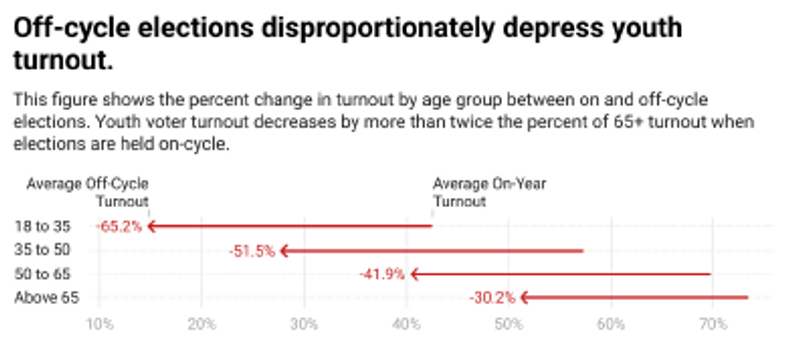
Because of the disparate burdens off-cycle election impose on young voters and voters of color, turnout among these groups, expressed as a proportion of white turnout, is significantly lower in off-year elections, as shown in Figures 3 and 4. This means that off-cycle electorates are disproportionately whiter and older than on-cycle electorates.
Figure 3: Average Ratio of Minority Voters to White Voters in Elections, 2014-2022, in the Sixteen Studied Counties

Figure 4: Average Ratio of 18-35 Year Old Voters to Over 65 Year Old Voters in Elections, 2014-2022, in the Sixteen Studied Counties
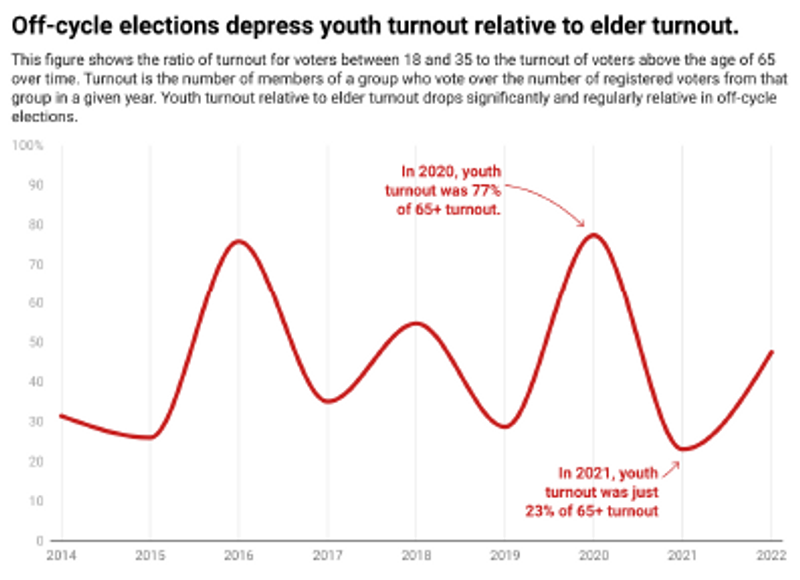
In addition to these detrimental effects on voters of color and young voters, ultimately, all voters lose when town and county elections are held off-cycle. Figures 5 and 6 show that turnout among all voters—including white voters—drops off meaningfully in off-cycle elections, as compared to on-cycle elections.
Figure 5: Average Voter Turnout by Race/Ethnicity, 2014-2022, for the Sixteen Studied Counties.
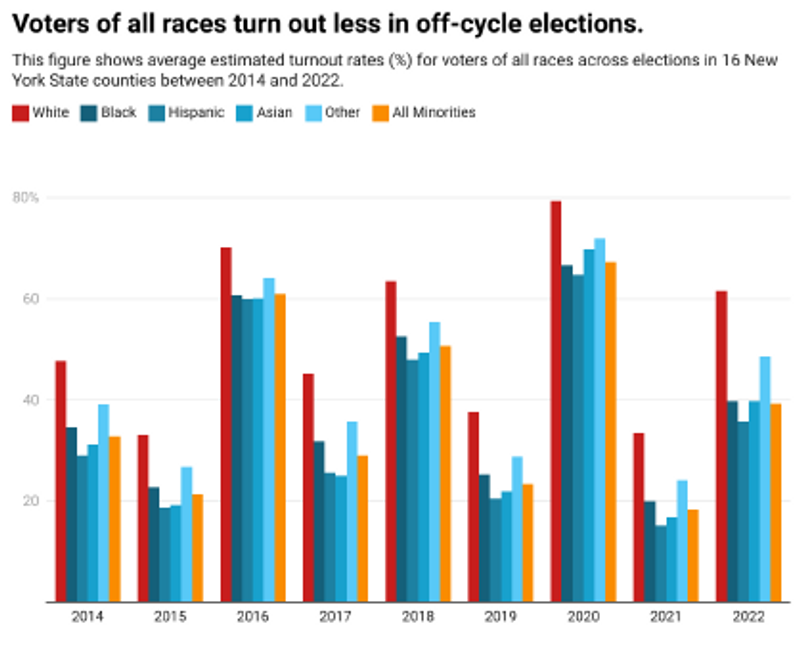
Figure 6: Average Voter Turnout in On- and Off-Cycle Elections by Race/Ethnicity, 2014-2022, for the Sixteen Studied Counties.
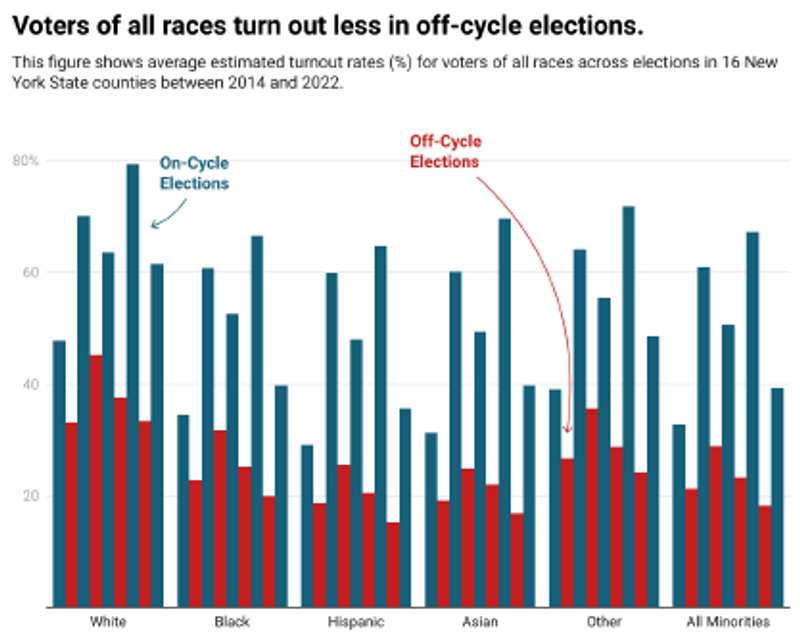
III. The Election Alignment Bill Will Promote Compliance with Federal and State Law
The Election Alignment Bill will prevent potential violations of federal and state voting rights laws by New York State and its towns and cities. It is unlawful for states and local governments to maintain racially discriminatory off-cycle elections. The federal Voting Rights Act prohibits practices—including off-cycle elections—that “result[] in a denial or abridgement of the right of any citizen of the United States to vote on account of race, color, [or language-minority status].” 16 A violation of the statute exists when “it is shown that the political processes leading to nomination or election in the State or political subdivision are not equally open to participation by members of [protected classes] in that [their] members have less opportunity than other members of the electorate to participate in the political process and to elect representatives of their choice.”17 Similarly, the John R. Lewis Voting Rights Act of New York (the “NYVRA”) prohibits practices—including off cycle elections—whenever it is shown that “based on the totality of the circumstances, members of a protected class have less opportunity than the rest of the electorate to elect candidates of their choice or influence the outcome of elections.”18 By shifting most “off-cycle” town and county elections “on-cycle” to even years through the Election Alignment Bill, New York will facilitate compliance with federal and state law.
For the above reasons, we strongly encourage you to sign the Election Alignment Bill. Please feel free to contact Michael Pernick (mpernick@naacpldf.org), Steven Lance (slance@naacpldf.org), Ruth Greenwood (rgreenwood@law.harvard.edu), or Perry Grossman (pgrossman@nyclu.org) with any questions or to discuss these issues in more detail.
Sincerely,
Asian American Legal Defense and Education Fund (AALDEF) Brennan Center for Justice at NYU School of Law
Center for Law and Social Justice At Medgar Evers College (CLSJ) Election Law Clinic at Harvard Law School
Generation Vote
LatinoJustice PRLDEF
Long Island Center for Independent Living, Inc.
NAACP Legal Defense and Educational Fund, Inc. (LDF)
New York Civil Liberties Union (NYCLU)
Reinvent Albany
1 See generally, e.g., Zoltan L. Hajnal, Vladimir Kogan, & G. Agustin Markarian, Who Votes: City Election Timing and Voter Composition, 116 AM. POL. SCI. REV. 374, (2022) [hereinafter Hajnal et al., Who Votes]; SARAH ANZIA, TIMING AND TURNOUT: HOW OFF-CYCLE ELECTIONS FAVOR ORGANIZED GROUPS (2014); Christopher Berry & Jacob E. Gersen, The Timing of Elections, 77 U. CHI. L. REV 37 (2011).
2 See, e.g., Joseph T. Ornstein, Municipal Election Timing and the Politics of Urban Growth 8 – 9
(Apr. 30, 2018) (on file with University of Michigan) (“The most prominent consequence of holding elections off-cycle is lower voter turnout...[b]ut this decrease in turnout is not uniform.”) [hereinafter, Ornstein, Municipal Election Timing].
3 Hajnal et al., Who Votes at 374.
4 Id.
5 Vladimir Kogan, Stephane Lavertu, Zachary Peskowitz, Election Timing, Electorate Composition, and Policy Outcomes: Evidence from School Districts, 62 AM. J. POL. SCI. 637, 644 (2018) [hereinafter Kogan et al., Election Timing].
6 Hajnal et al., Who Votes at 374.
7 Kogan et al., Election Timing, at 645.
8 Hajnal et al., Who Votes, at 379; see also Ornstein, Municipal Election Timing, at 9 – 10.
9 Hajnal et al., Who Votes, at 377 – 381.
10 Melissa Marschall & John Lappie, Turnout in Local Elections: Is Timing Really Everything, 17 Election L.J. 221 (2018). Zoltan Hajnal & Jessica Troustine, Where Turnout Matters: The Consequences of Uneven Turnout in City Politics, Journal of Politics, 67 J. POL. 515, 521 – 523 (2005).
11 Hajnal & Troustine, Where Turnout Matters at 521 – 523.
12 Alan S. Gerber, Donald P. Green & Ron Shachar, Voting May Be Habit-Forming: Evidence from a Randomized Field Experiment, 17 Amer. J. Pol. Sci. 540, 549 (2003). These long-term benefits can be expected in part because the “habit” of voting is “an outgrowth of changed self-perception” about one’s own voting behavior. Id. While, according to one study’s authors, “the schedule of frequent and often low-salience elections typical of the United States contributes to the breakdown of voting habits by offering many opportunities for abstention,” aligning election schedules can have the opposite effect, “increas[ing] the proportion of the electorate who describe themselves as ‘voters,’ a self-perception that would be expected to persist over time and to predict subsequent voting rates.” Id.
13 The conclusions of this study are reported in this letter, and the underlying code and data are on file with the Harvard Election Law Clinic.
14 Specifically, the study relied on Bayesian-Inference Surname Geocoding (BISG), a well-accepted methodology that uses geocoded address and surname to refine Census data and provide estimates of voter activity based on race and ethnicity. See e.g. Nat’l Ass’n for Advancement of Colored People, Spring Valley Branch v. E. Ramapo Cent. Sch. Dist., 462 F. Supp. 3d 368, 382 (S.D.N.Y. 2020), aff'd sub nom. Clerveaux v. E. Ramapo Cent. Sch. Dist., 984 F.3d 213 (2d Cir. 2021).
15 The counties included in the analysis provided in this letter are Albany, Broome, Erie, Franklin, Monroe, Montgomery, Nassau, Onondaga, Orange, Putnam, Rockland, Schenectady, Suffolk, Sullivan, Ulster, and Westchester.
16 See 52 U.S.C. § 10301; see, e.g. Compl., Citizens Project v. City of Colorado Springs, No. 22-cv-1365 (D. Colo. Jun. 1, 2022), ECF No. 1.
17 52 U.S.C. § 10301.
18 N.Y. Elec. Law § 17-206(1).
